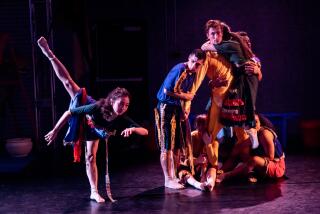Sharing Their Vision
- Share via
The oldest, most basic relationship in dance is between music and movement, and most performers leave it unquestioned.
Not so American cellist Walter Haman and Venezuelan modern dancer Jose Navas.
In their two-part collaboration Haman/Navas Project, presented by Navas’ Compagnie Flak (based in Montreal) at the Skirball Cultural Center on Thursday, these artists explored unusual connections and modes of shared expression that gave their performance great intimacy and immediacy.
The small, dark, nervy Navas and the tall, blond, reserved Haman started their 40-minute duet at the far end of the stage space, both dressed in black.
Navas began in profile, executing slow-motion walks, while Haman, seated but not playing, faced away from the audience.
As the room darkened and Navas began restlessly rolling and stretching on the floor, the silence of the room and isolation of the dancer loomed larger than anything specific in the movement.
Finally Haman began playing Allan Hovhaness’ “Yakamochi,” a suite of many moods and kinds of attack.
Indeed, the range of the music often seemed greater than that of the dancing.
For all his supple, intuitive power as a dancer, Navas always seemed driven by windblown arms and not always as compelling in his development of steps as in his use of the upper limbs and torso.
Early in the piece, after Haman moved his chair to face front, Navas stood behind him, covering the cellist’s eyes with one hand and touching his chest with the other during a fast, turbulent piece played with almost contemptuous exactitude.
This startling tableau--the dancer immobile, his own eyes closed, the musician furiously active despite the invasion of his space--shattered the customary separate-but-equal politesse of music and dance, replacing it with a shared meditative union.
From this moment on, the interplay between Haman and Navas took many forms, from the dancer circling the cellist while chattering rapidly in Spanish about a Caracas earthquake to the cellist mirroring, in miniature, the dancer’s onstage costume change by removing his own shoes and socks.
Haman’s eyes intently followed Navas during the piece’s second half, in which Benjamin Britten’s Suite for Cello set formidable technical challenges for the musician and propelled the dancer through increasingly bold movement patterns.
Lighting by Marc Parent sometimes left one or the other briefly in silhouette but most often made their artistic interdependence a small, bright exception to the surrounding darkness.
At the end, racing figurations on Haman’s cello inspired Navas’ dramatic turns on the floor with arms flung overhead: a last exhilarating statement of something deeper and more mysterious than mere collaborative excellence: a sense, perhaps, that each artist had completed the other’s vision.
More to Read
The biggest entertainment stories
Get our big stories about Hollywood, film, television, music, arts, culture and more right in your inbox as soon as they publish.
You may occasionally receive promotional content from the Los Angeles Times.










